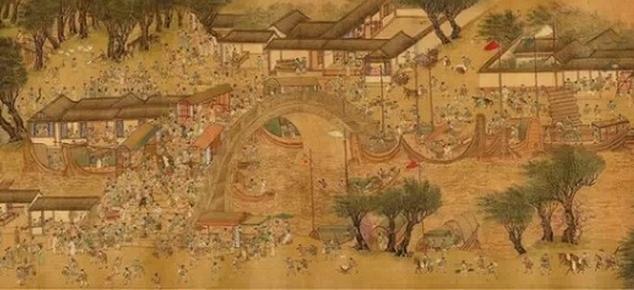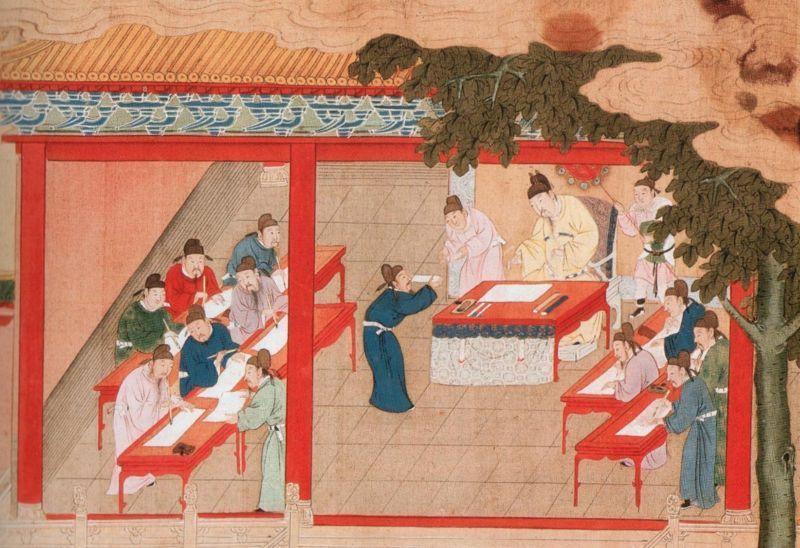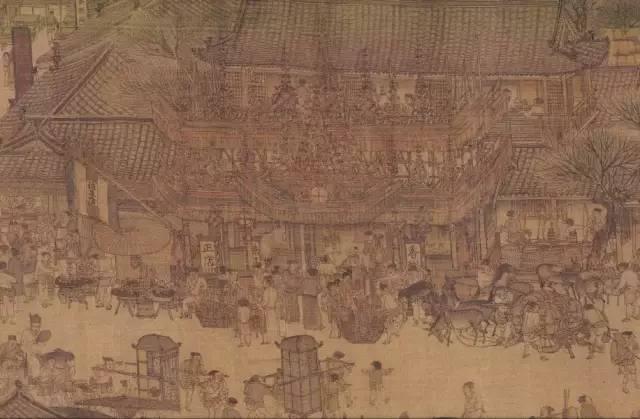Social Reforms and Highly Developed Civilization of the Song Dynasty
8 min readBy implementing a series of measures designed to intensify its centralized regime, the Northern and Southern dynasties ended the division since the end of Tang Dynasty and achieved reunification and stability. In the mean time, the troops and people in the central plains bravely fought against attacks from the northern nomad ethnic groups, offering a relatively peaceful environment for the southern areas that saw fast social and economic growth.
The Song Dynasty inherited and further developed the reforms adopted since the Sui and Tang dynasties, pushing forward profound changes in society.

The Song Dynasty “didn’t curb land merge”and allowed free sales of land. In the middle Northern Song Dynasty, most of the land had been privately owned by middle and sma1l landlords. Agriculture and handicraft sectors saw the development of contract relationships. Tenant peasants and craftsmen were formally registered b the state. The landlord economy based on land tenancy system and yeoman economy jointly took a major position of social economy, private handicraft workshops en joyed rapid growth, too. In 1027, Emperor Renzong explicitly ordered that tenantpeasants could move freely after the tenancy contracts ended, and the land owners couldn’t arbitrarily block their way. Later on, it was further stipulated that landlords couldn’t use the tenant peasants’ families as servants. In case of death of a tenant peasant,”his wife who gets remarried is allowed to do so and hisdaughter can marry anybody she likes.”Besides, most handicraft workshops also employed craftsmen, paying their wages based on contracts, making craftsmen relatively free and resulting in loose personal dependency.
Adoption of land tenancy systems and employment systems was a landmark reform inproduction relations, resulting in high enthusiasm in the working people and much more social and economic growth.

The population at the end of the Northern Song Dynasty increased to 100 million, offering vast numbers for the workforce. Large-scale reclamation of terrace and low-lying fields resulted in more farming land-twice the area as before. New types of farm ware, like plowshares with steel blades and seedling horses for paddy rice planting, were widely used for intensive farming. Champa paddy rice,a superior breed from Vietnam, was introduced and popularized, too, greatly increasing grainoutput. In the Southern Song Dynasty, the proverb known as “When the area around Dongting Lake has a good harvest, the entire country has enough food”had spread across the country, showing that the national economic center has shifted from the Yellow River basins to the Yangtze River basins.
The Song Dynasty saw big progress in its handicraft sector and boasted the world’s No.1 coal exploitation yields.The site of a coal mine from the late Northern Song Dynasty,located in Hebi,Henan,has a laneway as long as 500 m that could accommodate hundreds of miners.Its facilities for lighting,ventilation anddrainage and exploitation techniques were close to the levels in modern history.Also,smelted metals such as iron and copper also represented the world’s highest level of the time either in quality or quantity.During the regime of Emperor Shenzong of the Northern Song Dynasty,up to 100,000 copper-smelting craftsmen worked around Qianshan,Xinzhou alone.It is estimated that the iron output of the Song Dynasty roughly equaled the combined output of all the European countries in the 18th century.At the end of the Southern Song Dynasty,coke was used in iron smelting.As for the textile sector,cotton spinning rose during the Southern Song Dynasty,with new types of tools like spinning wheels,catapults and weaving machines.This was in addition to the development of traditional silk weaving that was characterized by more colorful patterns and more diversified categories.The porcelain-making sector was also taken to a new stage.The black and white porcelains produced in Jingdezhen,Jiangxi,were sold both at home and abroad,whicl is the origin of China,literally meaning“the country of porcelains.”

The Song Dynasty boasted an unprecedented prosperous commodity economy. Commercial activities went beyond the restrictions imposed since the Tang Dynasty,such as designated places and time for transactions.A large number of commodity distribution places emerged around cities and major traffic routes in rural areas,leading to the formation of bazaars and towns of different sizes.In the Northern Song Dynasty,a commercial tax was levied in towns under the county level,resulting in dense commercial tax networks and making the commercial tax one of the ma jor revenues for governments.In the early 1lth century,Sichuan saw the presence of the world’s earliest paper currency-Jiaozi,which was designed to facilitate transactions.In the Southern Song Dynasty,Huizi and other types of paper currencies were widely used in circulation.Credit transactions with written deadlines and pledged by the rich emerged,too,as well as other commercial means o payment like Biangianwu,an officially-operated financial organization for exchange,Didian for storage and negotiation and Zhiku for mortgage.A needle shop in Jinan,Shandong,designed its signpost like this:on the upper side was its name“Jinan Liujia Needle Shop.”In the middle was a white rabbit that was accompanied by the words“recognizing the white rabbit in front of the shop as the symbol”on both sides.On the lower part were the messages for advertisement:“the needles made of superior steel bars are thin and easy to use.Any one who buys the needles in largequantities for wholesale can enjoy special offers.”That is a proof of the presence of trademarks and advertisements in the Song Dynasty,and the formation of the business mode combining raw material procurement,processing and wholesale. According to Prosperities and Dreams in the Eastern Capital,the”transactions of gold,silver and silk”in Bianjing of the Northern Song Dynasty took place in a lane in the southern part,where“buildings were spectacular and shops were spacious,”and“every deal involved an amazing sum of money,”resembling today’s financial street.The city of Bianjing saw densely-distributed shops in more than 400 sectors,including big markets of rice,vegetables,meat,fish and fruits,cloth,scarves,folding fans,belts,combs,needles and ironware,as well as high-grade gold and silver shops and jewelry shops.In addition to these shops,morning and night fairs along the streets took place.
The Song Dynasty also boasted an extremely advanced ship-making sector and oceannavigation techniques.Large-sized ships capable of carrying tens of thousands of shi of grains were equipped with sealed cofferdams and drew deep with their pointed bottoms.Compasses were adopted for navigation,making trips more safe and speedy. Encouraged by the governments, foreign trade developed quickly, with trading ships traveling to the West Pacific Ocean, Indian Ocean and Persian Gulf, and trade links with more than 50 countries and regions. In addition, the superintendencies of merchant shipping were established at important ports for administration. “Fanfang”was set up as the places for the foreign merchants to live, where “Fan Markets”and “Fan Schools”were available and Arabian merchants were allowed to build mosques and public tombs as well. In the Southern Song Dynasty, Quanzhou roseto be the world’s biggest international trade port. The combined foreign trade taxcollected by the superintendencies of merchant shipping in Quanzhou and Guangzhou was as much as 2,000,000 guan, making up a big part of the government’s revenue.
With the economic development and social progress, the social structure and social life in the Song Dynasty experienced profound changes.
The Song Dynasty saw the final withdrawal of the scholar-bureaucrats from the historical stage. The commoner-landlords who became officials through imperial examinations took major positions and constituted the backbone of the royal ruling. The”cultivating officials”policy that highlighted preferential treatment ofscholars made “not killing ministers, scholars and advisors”as the “domestic disciplines passed down from ancestors,”and offering high salaries and treatment for officials at various levels. That resulted in a loose and rational politicalatmosphere. According to the history record, Emperor Shenzong of the Song Dynasty once wanted to kill an official guilty of a crime but was stopped by his ministers by citing the “domestic disciplines.”He then changed his mind and decided to send the official into exile, to which the ministers responded by saying,”it is better to die when life is a disgrace.”Emperor Shenzong sighed, saying,”It’s hard to do even one thing that could make him feel good.”The ministers said,”He might as we11 not do such kind of pleasant things.”
Since the Tang and Song dynasties, the country had implemented the policy of sharing profits between the government and the businessmen. With this policy, the troublesome operation of the government-run businesses and franchised businesses wascontracted to the businessmen and part of the franchised business profits was shared with the businessmen. There were franchise certificates such as salt certificates and tea certificates for monopolized products. The participation of the businessmenimproved efficiency and total profits. The actual income of the government from thefranchised products was increased manifold though it was only a share of the total profits. Many businessmen, especially the salt businessmen, cooperated with the government and got rich while serving the country, enjoying a respectable position. The Song Dynasty removed the former restrictions that descendants of those engagedin industrial and commercial businesses couldn’t be promoted as officials, and some rich businessmen even had marriages with the royal families and officials of thecourt. Every time when the results of imperial examination for official selection were released, the rich would hurry to select the successful candidates to be their sons-in-law, which was called “catching sons-in-law upon release of the candidates list.”
The yeomen and semi-yeomen in the Song Dynasty accounted for more than 50 percent of the total population, and tenant peasants took up 35 percent. Both the tenant peasants and craftsmen were rendered the status of civilians.
Economic growth and the rise of cities led to the increaseof the urban population in the Song Dynasty. Those non-peasant urban residents constituted the citizen class, which was dominated by businessmen, scholars and intellectuals of th upper class, craftsmen in various fields, as well as mountebanks, fortune-tellers, street artists and coolies. In the city of Bianjing, as shown in Along the River during the Qingming Festival,a well-known painting of the Song Dynasty, the people depicted are from all walks of life, including carpenters, blacksmiths, silversmiths, pottery makers, barrel makers, painters, grass shoe weavers, fan makers and mirror makers, as well as those selling oil, salt, paper, porridge, cakes, spices and drugs. They are jostling each other in the crowd and working hard for their own businesses, rendering the city extreme vigor and vitality.
An overwhelming majority of the population in the Song Dynasty lived in rural areas, most of whom could maintain their daily life and enjoyed a better life quality. Villagers would watch opera, listen to story-telling and have other fun during their leisure time, greatly enriching their cultural life.
A thriving commodity economy and the growth of the citizen class gave rise to booming citizen culture. Restaurants, hotels and teahouses were widespread, with the bigger ones boasting a daily guest number of up to 1,000. Just as the description goes,”Flooded with talks and laughter, the places saw long queues of people and carriages waiting outside every time the dawn falls, and the business wouldn’t be much affected in case of poor weather.”The recreational places in the cities were called”washe,”where poetic dramas, acrobatics, history-telling, story-telling, sword-dancing and other popular programs were staged all night long, making those who passed by or spectators have no thought of leaving. The development and boomingof such recreational places best demonstrate the interests of the citizens and the thriving vitality of ordinary life.
The profound changes in the production relations and social structure during the Song Dynasty took social civilization to a higher level. Meanwhile, many fresh things that hadn’t been seen previously emerged, too, showing the trend of evolution toward modern society.








